7AAD0064: Manufacturing Strategies Report on R&D and Innovation
VerifiedAdded on 2022/09/11
|12
|2814
|15
Report
AI Summary
This report delves into various manufacturing strategies, emphasizing the pivotal role of Research and Development (R&D) in achieving a competitive edge. It explores methods like cost leadership, technology-based strategies, and operational effectiveness, highlighting how these approaches leverage R&D to minimize production costs and improve efficiency. The report also examines the integration of Artificial Intelligence (AI) and Machine Learning (ML) in R&D processes to automate tasks and facilitate data-driven decision-making. Furthermore, it identifies the drawbacks of these strategies, particularly in the context of Small and Medium Enterprises (SMEs) compared to global corporations, focusing on financial constraints, time requirements, and human resource implications. The report provides key performance indicators (KPIs) to measure the effectiveness of innovation efforts and discusses the importance of cross-functional implications for successful strategy implementation, covering aspects such as formulation, trade-offs, communication, and coordination. The report concludes by summarizing the discussed strategies and their impact on achieving competitive advantage in manufacturing.
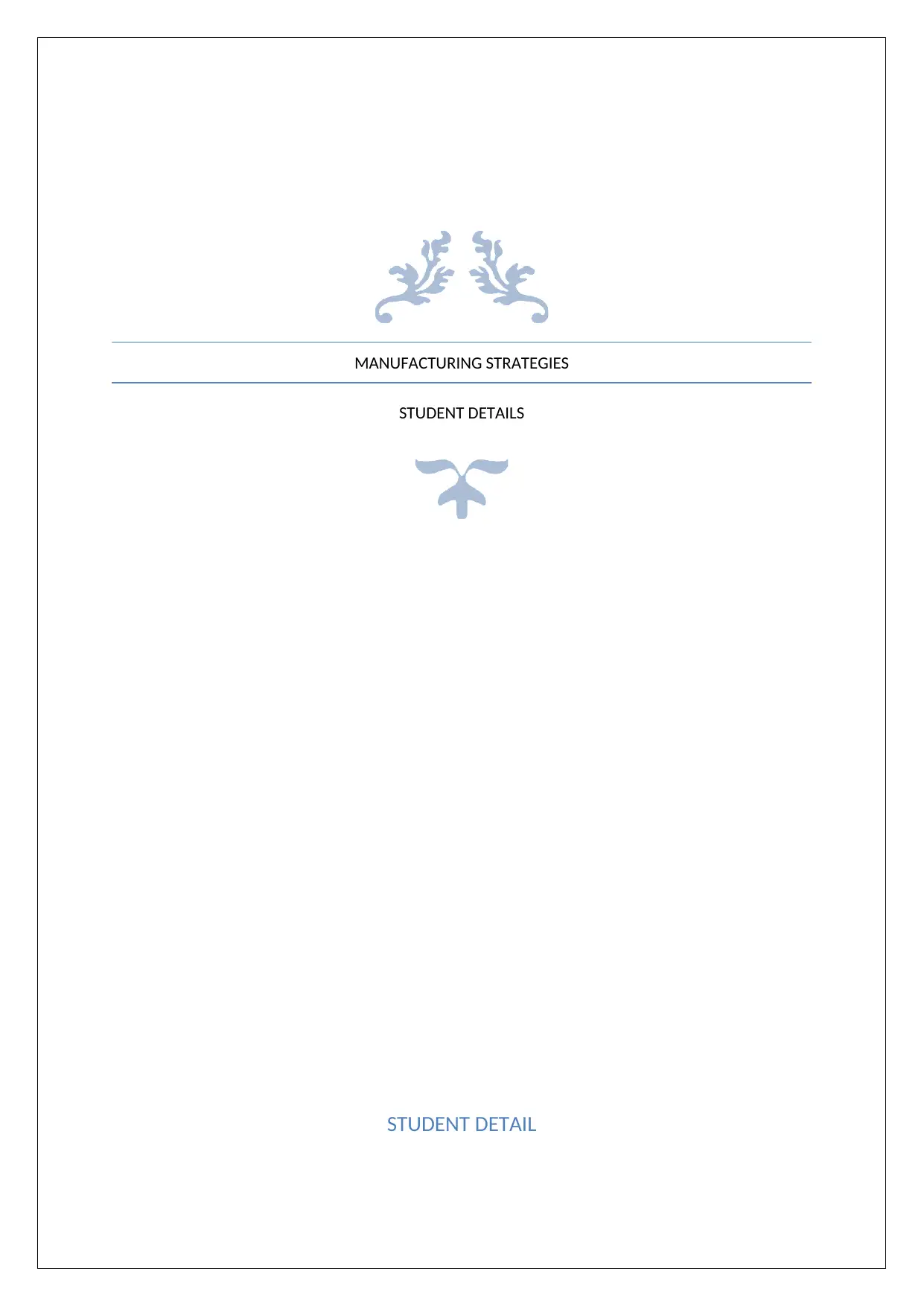
MANUFACTURING STRATEGIES
STUDENT DETAILS
STUDENT DETAIL
STUDENT DETAILS
STUDENT DETAIL
Paraphrase This Document
Need a fresh take? Get an instant paraphrase of this document with our AI Paraphraser
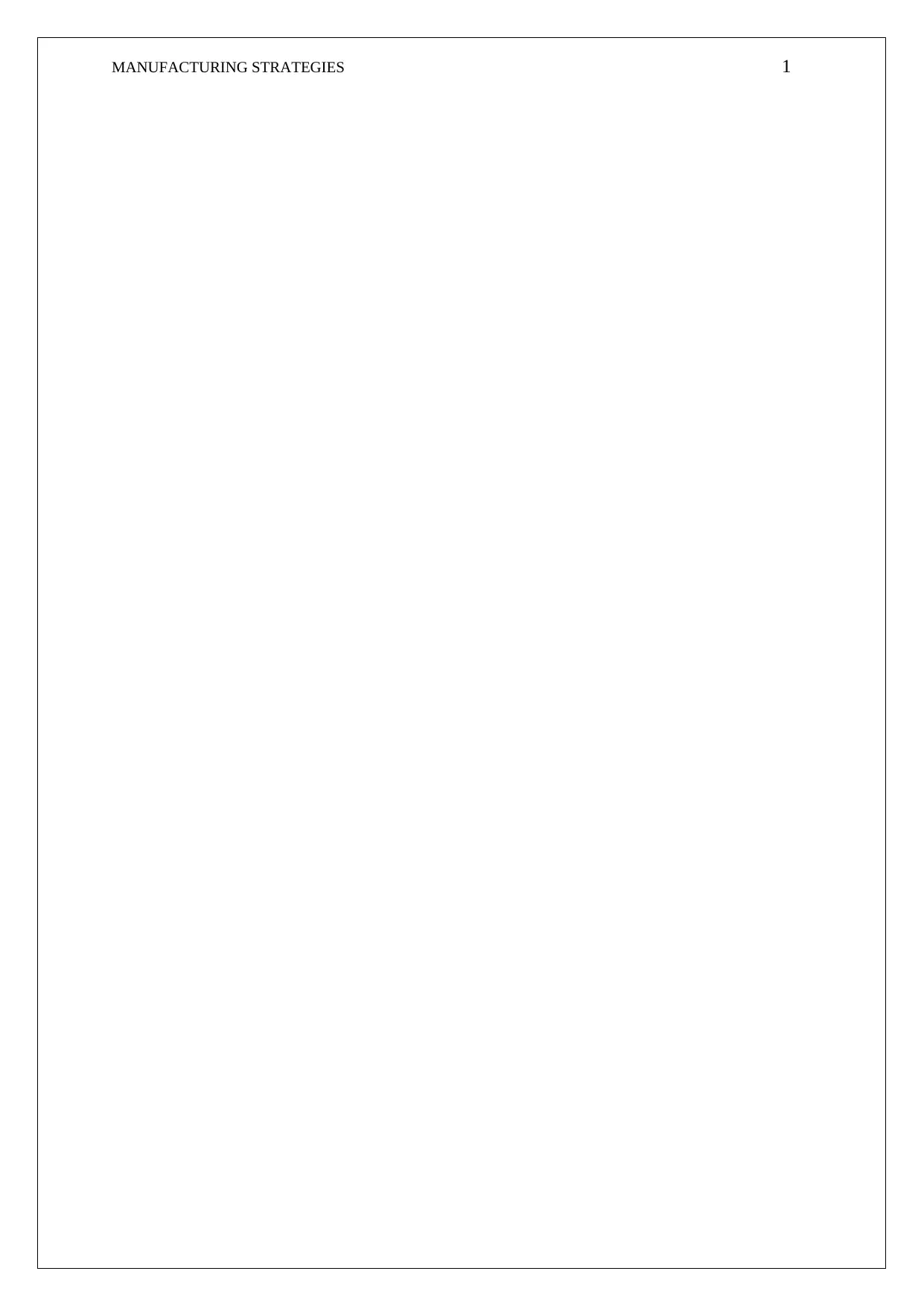
MANUFACTURING STRATEGIES 1
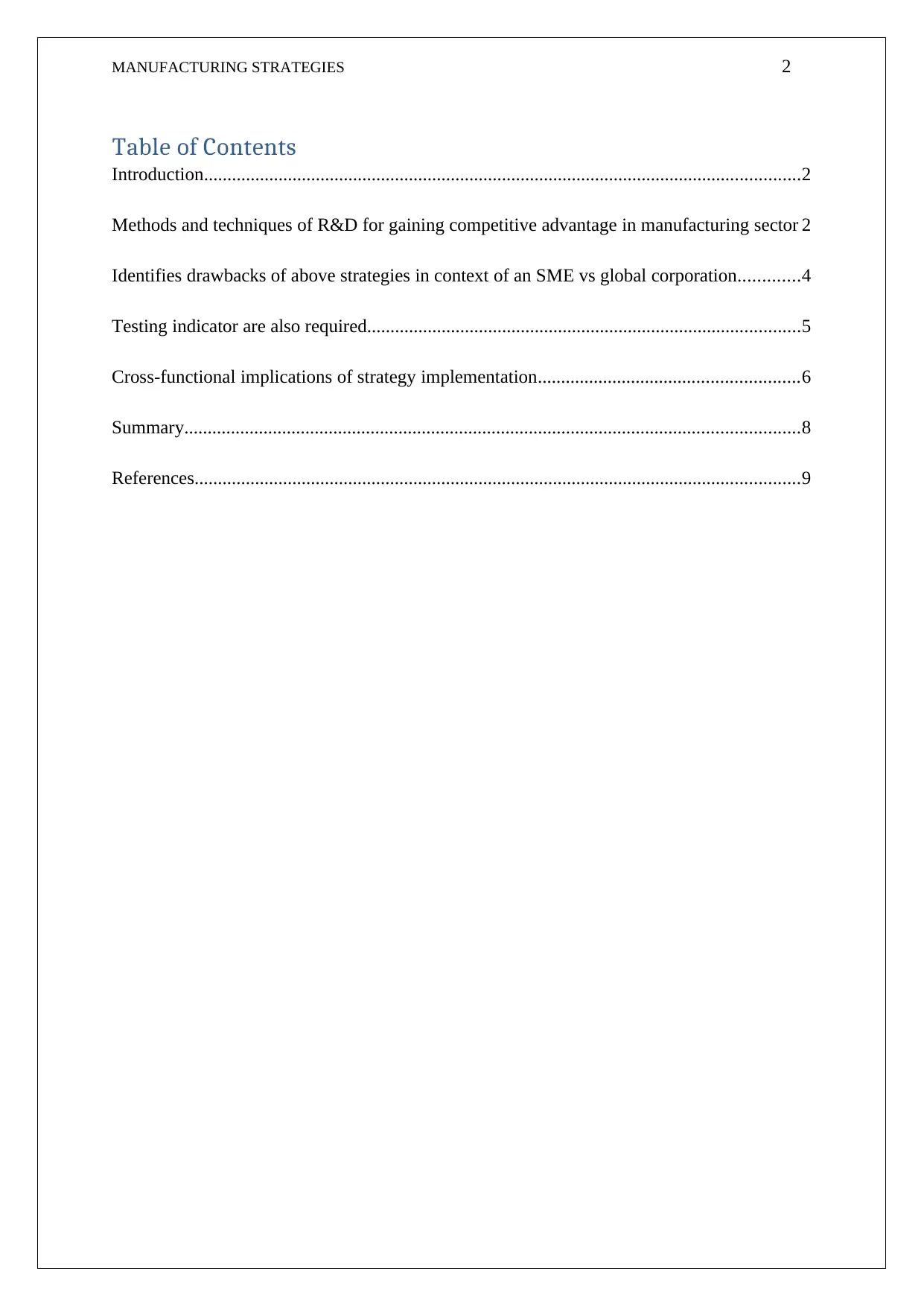
MANUFACTURING STRATEGIES 2
Table of Contents
Introduction................................................................................................................................2
Methods and techniques of R&D for gaining competitive advantage in manufacturing sector 2
Identifies drawbacks of above strategies in context of an SME vs global corporation.............4
Testing indicator are also required.............................................................................................5
Cross-functional implications of strategy implementation........................................................6
Summary....................................................................................................................................8
References..................................................................................................................................9
Table of Contents
Introduction................................................................................................................................2
Methods and techniques of R&D for gaining competitive advantage in manufacturing sector 2
Identifies drawbacks of above strategies in context of an SME vs global corporation.............4
Testing indicator are also required.............................................................................................5
Cross-functional implications of strategy implementation........................................................6
Summary....................................................................................................................................8
References..................................................................................................................................9
⊘ This is a preview!⊘
Do you want full access?
Subscribe today to unlock all pages.

Trusted by 1+ million students worldwide
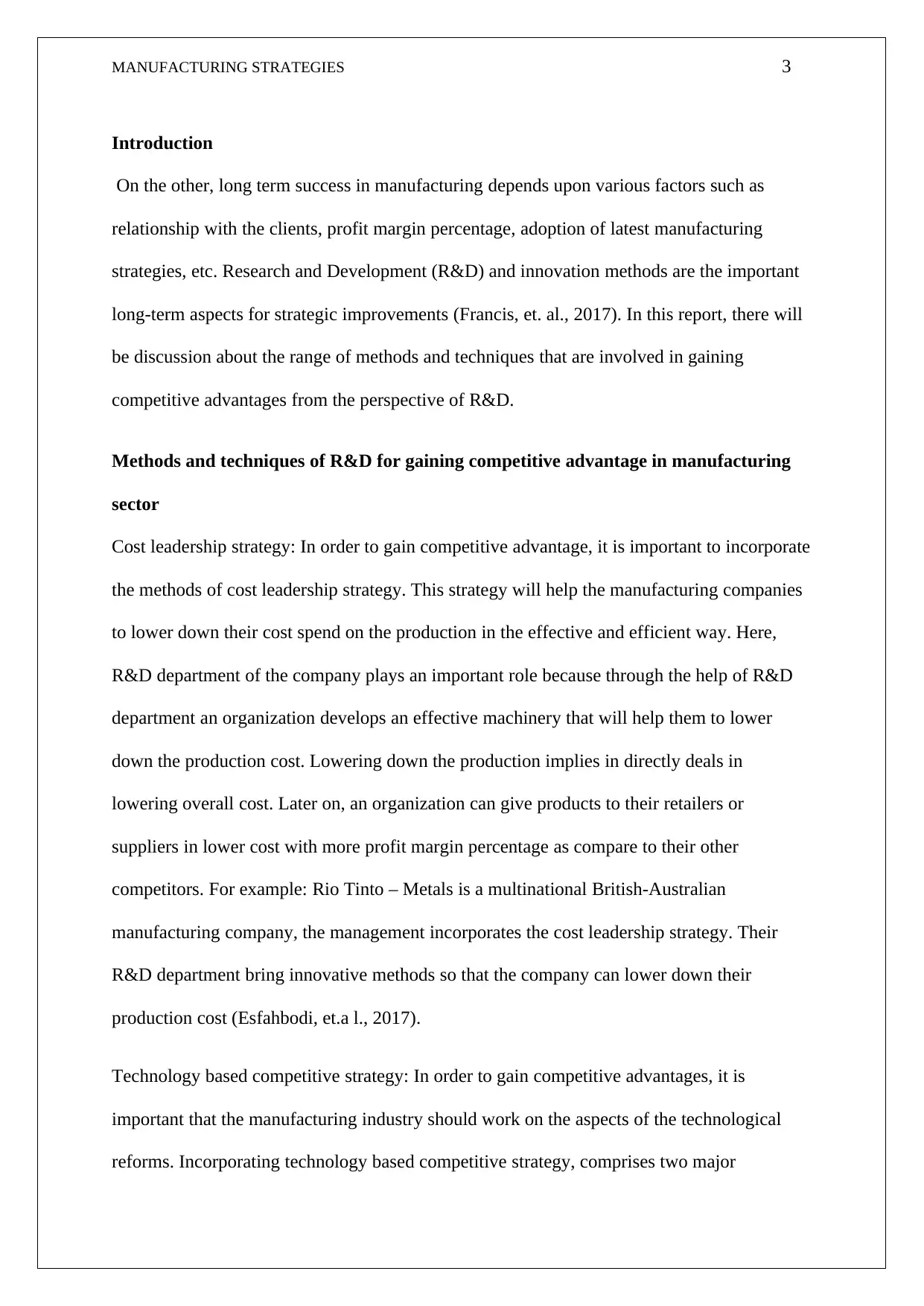
MANUFACTURING STRATEGIES 3
Introduction
On the other, long term success in manufacturing depends upon various factors such as
relationship with the clients, profit margin percentage, adoption of latest manufacturing
strategies, etc. Research and Development (R&D) and innovation methods are the important
long-term aspects for strategic improvements (Francis, et. al., 2017). In this report, there will
be discussion about the range of methods and techniques that are involved in gaining
competitive advantages from the perspective of R&D.
Methods and techniques of R&D for gaining competitive advantage in manufacturing
sector
Cost leadership strategy: In order to gain competitive advantage, it is important to incorporate
the methods of cost leadership strategy. This strategy will help the manufacturing companies
to lower down their cost spend on the production in the effective and efficient way. Here,
R&D department of the company plays an important role because through the help of R&D
department an organization develops an effective machinery that will help them to lower
down the production cost. Lowering down the production implies in directly deals in
lowering overall cost. Later on, an organization can give products to their retailers or
suppliers in lower cost with more profit margin percentage as compare to their other
competitors. For example: Rio Tinto – Metals is a multinational British-Australian
manufacturing company, the management incorporates the cost leadership strategy. Their
R&D department bring innovative methods so that the company can lower down their
production cost (Esfahbodi, et.a l., 2017).
Technology based competitive strategy: In order to gain competitive advantages, it is
important that the manufacturing industry should work on the aspects of the technological
reforms. Incorporating technology based competitive strategy, comprises two major
Introduction
On the other, long term success in manufacturing depends upon various factors such as
relationship with the clients, profit margin percentage, adoption of latest manufacturing
strategies, etc. Research and Development (R&D) and innovation methods are the important
long-term aspects for strategic improvements (Francis, et. al., 2017). In this report, there will
be discussion about the range of methods and techniques that are involved in gaining
competitive advantages from the perspective of R&D.
Methods and techniques of R&D for gaining competitive advantage in manufacturing
sector
Cost leadership strategy: In order to gain competitive advantage, it is important to incorporate
the methods of cost leadership strategy. This strategy will help the manufacturing companies
to lower down their cost spend on the production in the effective and efficient way. Here,
R&D department of the company plays an important role because through the help of R&D
department an organization develops an effective machinery that will help them to lower
down the production cost. Lowering down the production implies in directly deals in
lowering overall cost. Later on, an organization can give products to their retailers or
suppliers in lower cost with more profit margin percentage as compare to their other
competitors. For example: Rio Tinto – Metals is a multinational British-Australian
manufacturing company, the management incorporates the cost leadership strategy. Their
R&D department bring innovative methods so that the company can lower down their
production cost (Esfahbodi, et.a l., 2017).
Technology based competitive strategy: In order to gain competitive advantages, it is
important that the manufacturing industry should work on the aspects of the technological
reforms. Incorporating technology based competitive strategy, comprises two major
Paraphrase This Document
Need a fresh take? Get an instant paraphrase of this document with our AI Paraphraser
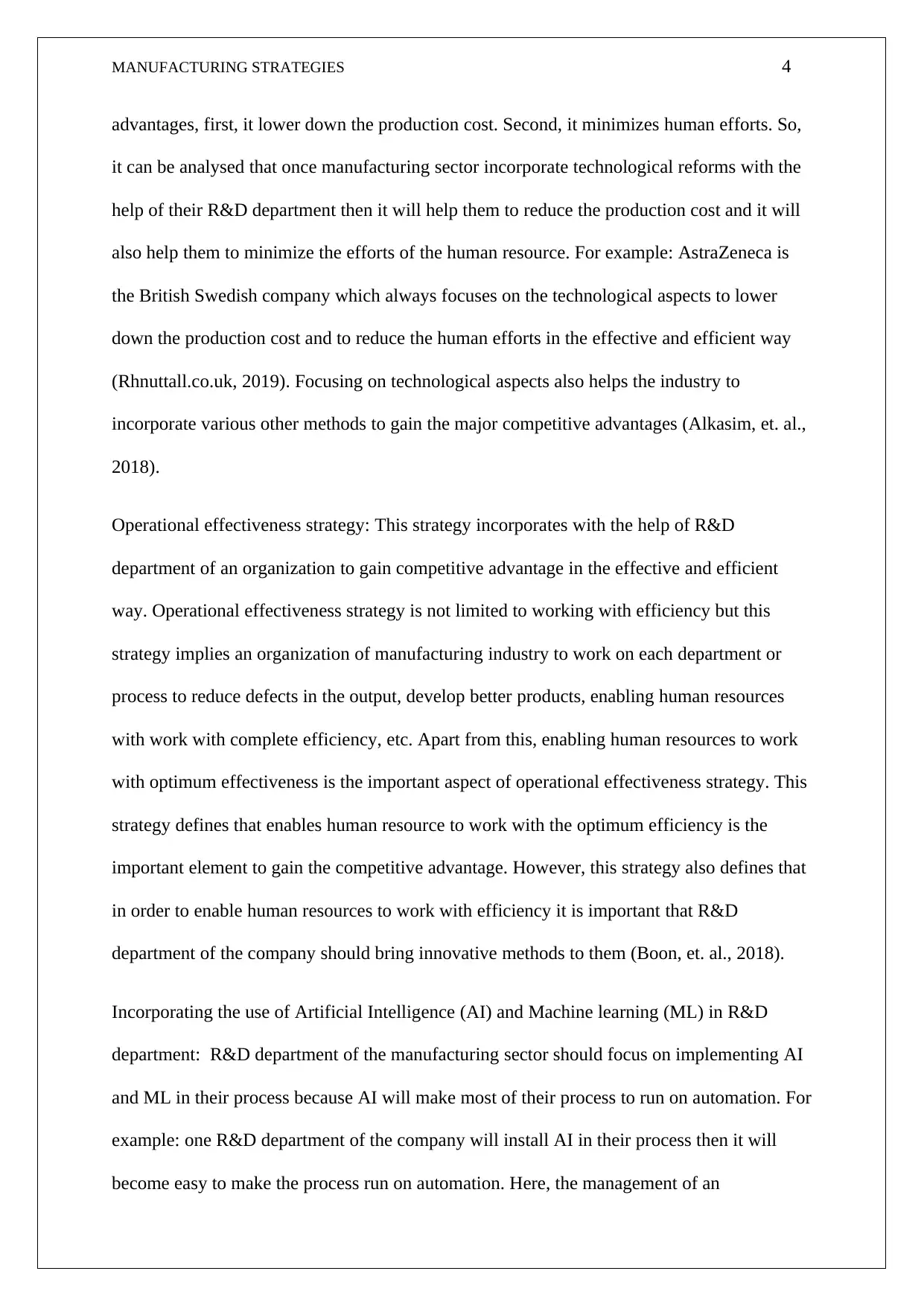
MANUFACTURING STRATEGIES 4
advantages, first, it lower down the production cost. Second, it minimizes human efforts. So,
it can be analysed that once manufacturing sector incorporate technological reforms with the
help of their R&D department then it will help them to reduce the production cost and it will
also help them to minimize the efforts of the human resource. For example: AstraZeneca is
the British Swedish company which always focuses on the technological aspects to lower
down the production cost and to reduce the human efforts in the effective and efficient way
(Rhnuttall.co.uk, 2019). Focusing on technological aspects also helps the industry to
incorporate various other methods to gain the major competitive advantages (Alkasim, et. al.,
2018).
Operational effectiveness strategy: This strategy incorporates with the help of R&D
department of an organization to gain competitive advantage in the effective and efficient
way. Operational effectiveness strategy is not limited to working with efficiency but this
strategy implies an organization of manufacturing industry to work on each department or
process to reduce defects in the output, develop better products, enabling human resources
with work with complete efficiency, etc. Apart from this, enabling human resources to work
with optimum effectiveness is the important aspect of operational effectiveness strategy. This
strategy defines that enables human resource to work with the optimum efficiency is the
important element to gain the competitive advantage. However, this strategy also defines that
in order to enable human resources to work with efficiency it is important that R&D
department of the company should bring innovative methods to them (Boon, et. al., 2018).
Incorporating the use of Artificial Intelligence (AI) and Machine learning (ML) in R&D
department: R&D department of the manufacturing sector should focus on implementing AI
and ML in their process because AI will make most of their process to run on automation. For
example: one R&D department of the company will install AI in their process then it will
become easy to make the process run on automation. Here, the management of an
advantages, first, it lower down the production cost. Second, it minimizes human efforts. So,
it can be analysed that once manufacturing sector incorporate technological reforms with the
help of their R&D department then it will help them to reduce the production cost and it will
also help them to minimize the efforts of the human resource. For example: AstraZeneca is
the British Swedish company which always focuses on the technological aspects to lower
down the production cost and to reduce the human efforts in the effective and efficient way
(Rhnuttall.co.uk, 2019). Focusing on technological aspects also helps the industry to
incorporate various other methods to gain the major competitive advantages (Alkasim, et. al.,
2018).
Operational effectiveness strategy: This strategy incorporates with the help of R&D
department of an organization to gain competitive advantage in the effective and efficient
way. Operational effectiveness strategy is not limited to working with efficiency but this
strategy implies an organization of manufacturing industry to work on each department or
process to reduce defects in the output, develop better products, enabling human resources
with work with complete efficiency, etc. Apart from this, enabling human resources to work
with optimum effectiveness is the important aspect of operational effectiveness strategy. This
strategy defines that enables human resource to work with the optimum efficiency is the
important element to gain the competitive advantage. However, this strategy also defines that
in order to enable human resources to work with efficiency it is important that R&D
department of the company should bring innovative methods to them (Boon, et. al., 2018).
Incorporating the use of Artificial Intelligence (AI) and Machine learning (ML) in R&D
department: R&D department of the manufacturing sector should focus on implementing AI
and ML in their process because AI will make most of their process to run on automation. For
example: one R&D department of the company will install AI in their process then it will
become easy to make the process run on automation. Here, the management of an
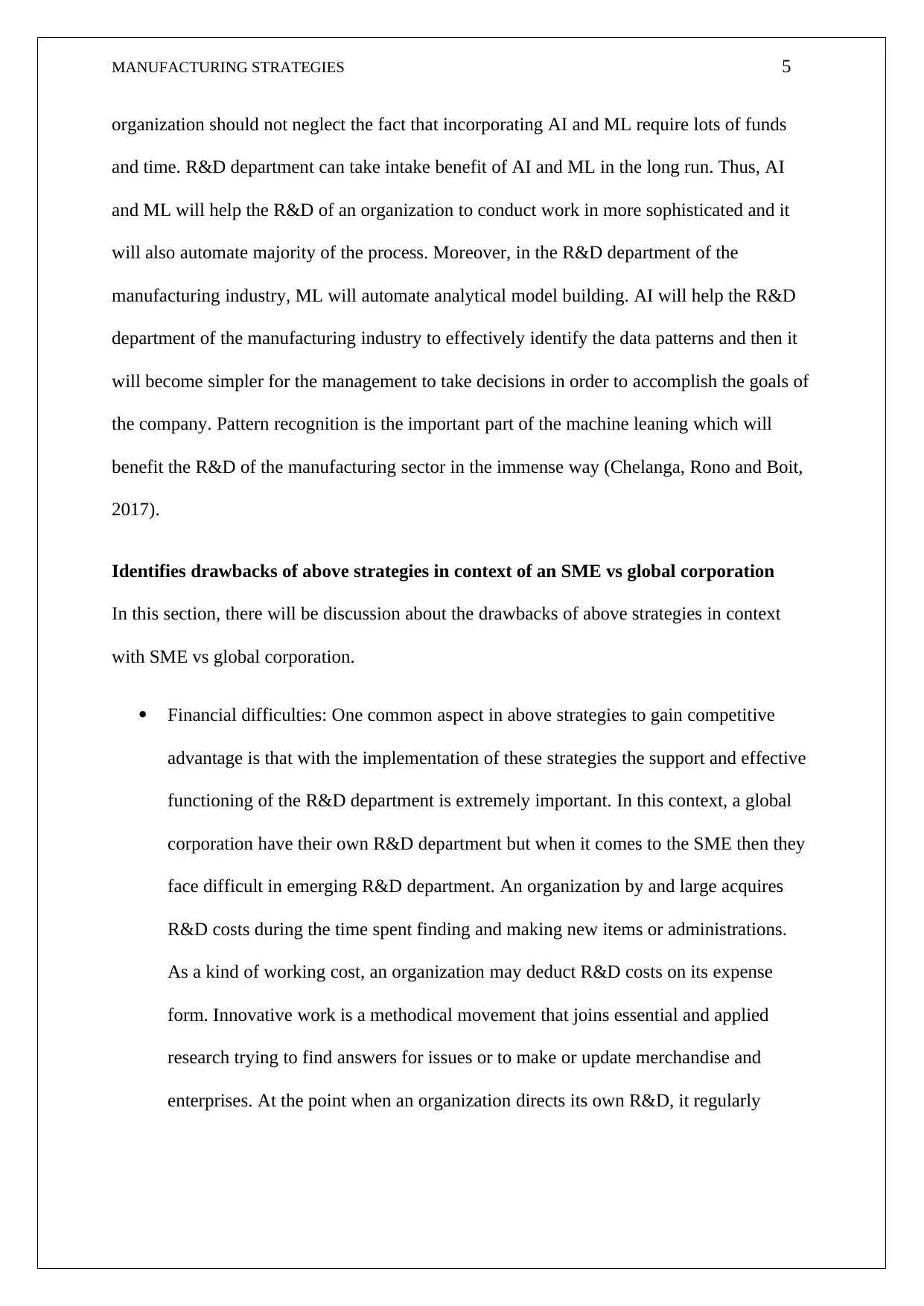
MANUFACTURING STRATEGIES 5
organization should not neglect the fact that incorporating AI and ML require lots of funds
and time. R&D department can take intake benefit of AI and ML in the long run. Thus, AI
and ML will help the R&D of an organization to conduct work in more sophisticated and it
will also automate majority of the process. Moreover, in the R&D department of the
manufacturing industry, ML will automate analytical model building. AI will help the R&D
department of the manufacturing industry to effectively identify the data patterns and then it
will become simpler for the management to take decisions in order to accomplish the goals of
the company. Pattern recognition is the important part of the machine leaning which will
benefit the R&D of the manufacturing sector in the immense way (Chelanga, Rono and Boit,
2017).
Identifies drawbacks of above strategies in context of an SME vs global corporation
In this section, there will be discussion about the drawbacks of above strategies in context
with SME vs global corporation.
Financial difficulties: One common aspect in above strategies to gain competitive
advantage is that with the implementation of these strategies the support and effective
functioning of the R&D department is extremely important. In this context, a global
corporation have their own R&D department but when it comes to the SME then they
face difficult in emerging R&D department. An organization by and large acquires
R&D costs during the time spent finding and making new items or administrations.
As a kind of working cost, an organization may deduct R&D costs on its expense
form. Innovative work is a methodical movement that joins essential and applied
research trying to find answers for issues or to make or update merchandise and
enterprises. At the point when an organization directs its own R&D, it regularly
organization should not neglect the fact that incorporating AI and ML require lots of funds
and time. R&D department can take intake benefit of AI and ML in the long run. Thus, AI
and ML will help the R&D of an organization to conduct work in more sophisticated and it
will also automate majority of the process. Moreover, in the R&D department of the
manufacturing industry, ML will automate analytical model building. AI will help the R&D
department of the manufacturing industry to effectively identify the data patterns and then it
will become simpler for the management to take decisions in order to accomplish the goals of
the company. Pattern recognition is the important part of the machine leaning which will
benefit the R&D of the manufacturing sector in the immense way (Chelanga, Rono and Boit,
2017).
Identifies drawbacks of above strategies in context of an SME vs global corporation
In this section, there will be discussion about the drawbacks of above strategies in context
with SME vs global corporation.
Financial difficulties: One common aspect in above strategies to gain competitive
advantage is that with the implementation of these strategies the support and effective
functioning of the R&D department is extremely important. In this context, a global
corporation have their own R&D department but when it comes to the SME then they
face difficult in emerging R&D department. An organization by and large acquires
R&D costs during the time spent finding and making new items or administrations.
As a kind of working cost, an organization may deduct R&D costs on its expense
form. Innovative work is a methodical movement that joins essential and applied
research trying to find answers for issues or to make or update merchandise and
enterprises. At the point when an organization directs its own R&D, it regularly
⊘ This is a preview!⊘
Do you want full access?
Subscribe today to unlock all pages.

Trusted by 1+ million students worldwide
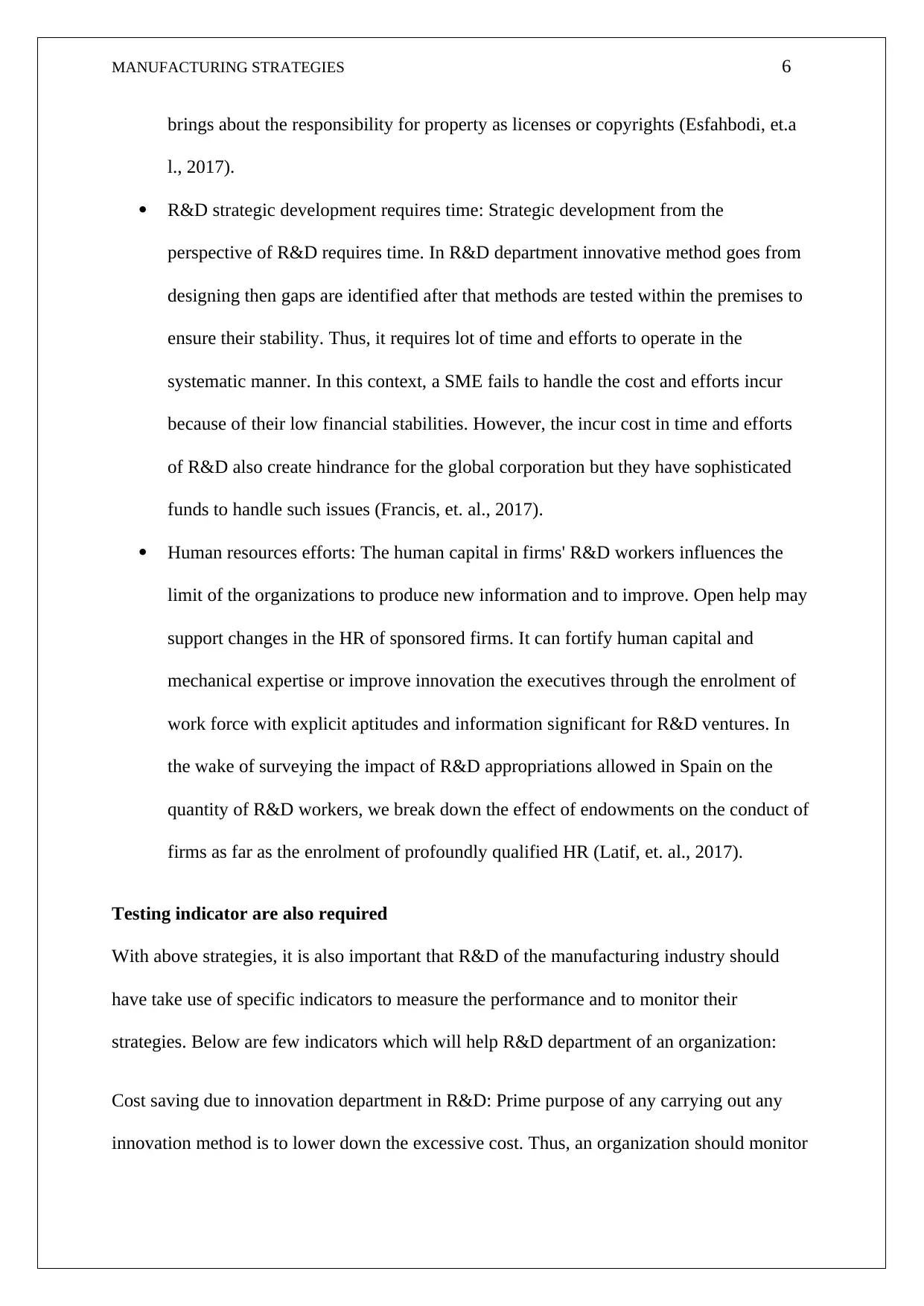
MANUFACTURING STRATEGIES 6
brings about the responsibility for property as licenses or copyrights (Esfahbodi, et.a
l., 2017).
R&D strategic development requires time: Strategic development from the
perspective of R&D requires time. In R&D department innovative method goes from
designing then gaps are identified after that methods are tested within the premises to
ensure their stability. Thus, it requires lot of time and efforts to operate in the
systematic manner. In this context, a SME fails to handle the cost and efforts incur
because of their low financial stabilities. However, the incur cost in time and efforts
of R&D also create hindrance for the global corporation but they have sophisticated
funds to handle such issues (Francis, et. al., 2017).
Human resources efforts: The human capital in firms' R&D workers influences the
limit of the organizations to produce new information and to improve. Open help may
support changes in the HR of sponsored firms. It can fortify human capital and
mechanical expertise or improve innovation the executives through the enrolment of
work force with explicit aptitudes and information significant for R&D ventures. In
the wake of surveying the impact of R&D appropriations allowed in Spain on the
quantity of R&D workers, we break down the effect of endowments on the conduct of
firms as far as the enrolment of profoundly qualified HR (Latif, et. al., 2017).
Testing indicator are also required
With above strategies, it is also important that R&D of the manufacturing industry should
have take use of specific indicators to measure the performance and to monitor their
strategies. Below are few indicators which will help R&D department of an organization:
Cost saving due to innovation department in R&D: Prime purpose of any carrying out any
innovation method is to lower down the excessive cost. Thus, an organization should monitor
brings about the responsibility for property as licenses or copyrights (Esfahbodi, et.a
l., 2017).
R&D strategic development requires time: Strategic development from the
perspective of R&D requires time. In R&D department innovative method goes from
designing then gaps are identified after that methods are tested within the premises to
ensure their stability. Thus, it requires lot of time and efforts to operate in the
systematic manner. In this context, a SME fails to handle the cost and efforts incur
because of their low financial stabilities. However, the incur cost in time and efforts
of R&D also create hindrance for the global corporation but they have sophisticated
funds to handle such issues (Francis, et. al., 2017).
Human resources efforts: The human capital in firms' R&D workers influences the
limit of the organizations to produce new information and to improve. Open help may
support changes in the HR of sponsored firms. It can fortify human capital and
mechanical expertise or improve innovation the executives through the enrolment of
work force with explicit aptitudes and information significant for R&D ventures. In
the wake of surveying the impact of R&D appropriations allowed in Spain on the
quantity of R&D workers, we break down the effect of endowments on the conduct of
firms as far as the enrolment of profoundly qualified HR (Latif, et. al., 2017).
Testing indicator are also required
With above strategies, it is also important that R&D of the manufacturing industry should
have take use of specific indicators to measure the performance and to monitor their
strategies. Below are few indicators which will help R&D department of an organization:
Cost saving due to innovation department in R&D: Prime purpose of any carrying out any
innovation method is to lower down the excessive cost. Thus, an organization should monitor
Paraphrase This Document
Need a fresh take? Get an instant paraphrase of this document with our AI Paraphraser
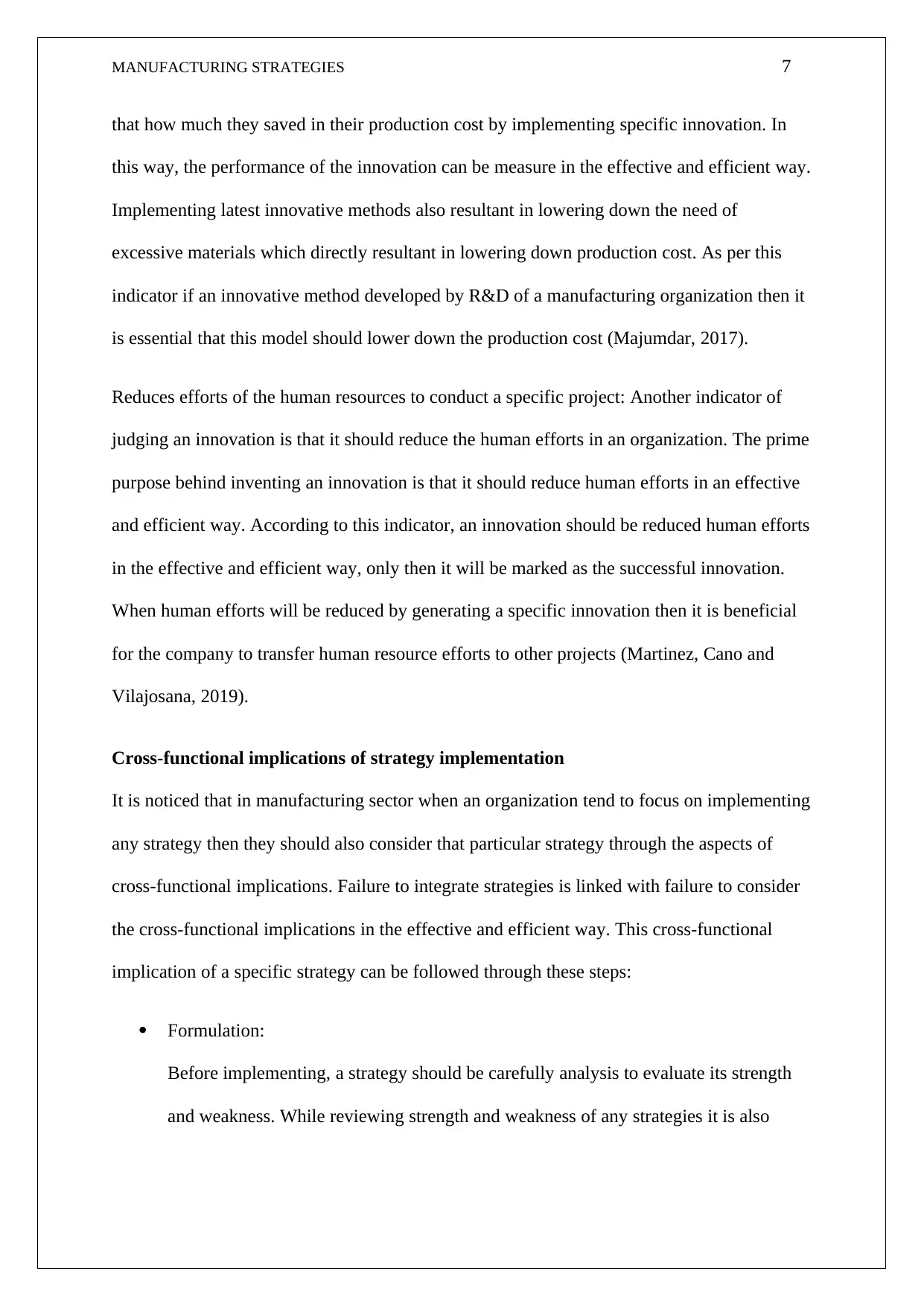
MANUFACTURING STRATEGIES 7
that how much they saved in their production cost by implementing specific innovation. In
this way, the performance of the innovation can be measure in the effective and efficient way.
Implementing latest innovative methods also resultant in lowering down the need of
excessive materials which directly resultant in lowering down production cost. As per this
indicator if an innovative method developed by R&D of a manufacturing organization then it
is essential that this model should lower down the production cost (Majumdar, 2017).
Reduces efforts of the human resources to conduct a specific project: Another indicator of
judging an innovation is that it should reduce the human efforts in an organization. The prime
purpose behind inventing an innovation is that it should reduce human efforts in an effective
and efficient way. According to this indicator, an innovation should be reduced human efforts
in the effective and efficient way, only then it will be marked as the successful innovation.
When human efforts will be reduced by generating a specific innovation then it is beneficial
for the company to transfer human resource efforts to other projects (Martinez, Cano and
Vilajosana, 2019).
Cross-functional implications of strategy implementation
It is noticed that in manufacturing sector when an organization tend to focus on implementing
any strategy then they should also consider that particular strategy through the aspects of
cross-functional implications. Failure to integrate strategies is linked with failure to consider
the cross-functional implications in the effective and efficient way. This cross-functional
implication of a specific strategy can be followed through these steps:
Formulation:
Before implementing, a strategy should be carefully analysis to evaluate its strength
and weakness. While reviewing strength and weakness of any strategies it is also
that how much they saved in their production cost by implementing specific innovation. In
this way, the performance of the innovation can be measure in the effective and efficient way.
Implementing latest innovative methods also resultant in lowering down the need of
excessive materials which directly resultant in lowering down production cost. As per this
indicator if an innovative method developed by R&D of a manufacturing organization then it
is essential that this model should lower down the production cost (Majumdar, 2017).
Reduces efforts of the human resources to conduct a specific project: Another indicator of
judging an innovation is that it should reduce the human efforts in an organization. The prime
purpose behind inventing an innovation is that it should reduce human efforts in an effective
and efficient way. According to this indicator, an innovation should be reduced human efforts
in the effective and efficient way, only then it will be marked as the successful innovation.
When human efforts will be reduced by generating a specific innovation then it is beneficial
for the company to transfer human resource efforts to other projects (Martinez, Cano and
Vilajosana, 2019).
Cross-functional implications of strategy implementation
It is noticed that in manufacturing sector when an organization tend to focus on implementing
any strategy then they should also consider that particular strategy through the aspects of
cross-functional implications. Failure to integrate strategies is linked with failure to consider
the cross-functional implications in the effective and efficient way. This cross-functional
implication of a specific strategy can be followed through these steps:
Formulation:
Before implementing, a strategy should be carefully analysis to evaluate its strength
and weakness. While reviewing strength and weakness of any strategies it is also
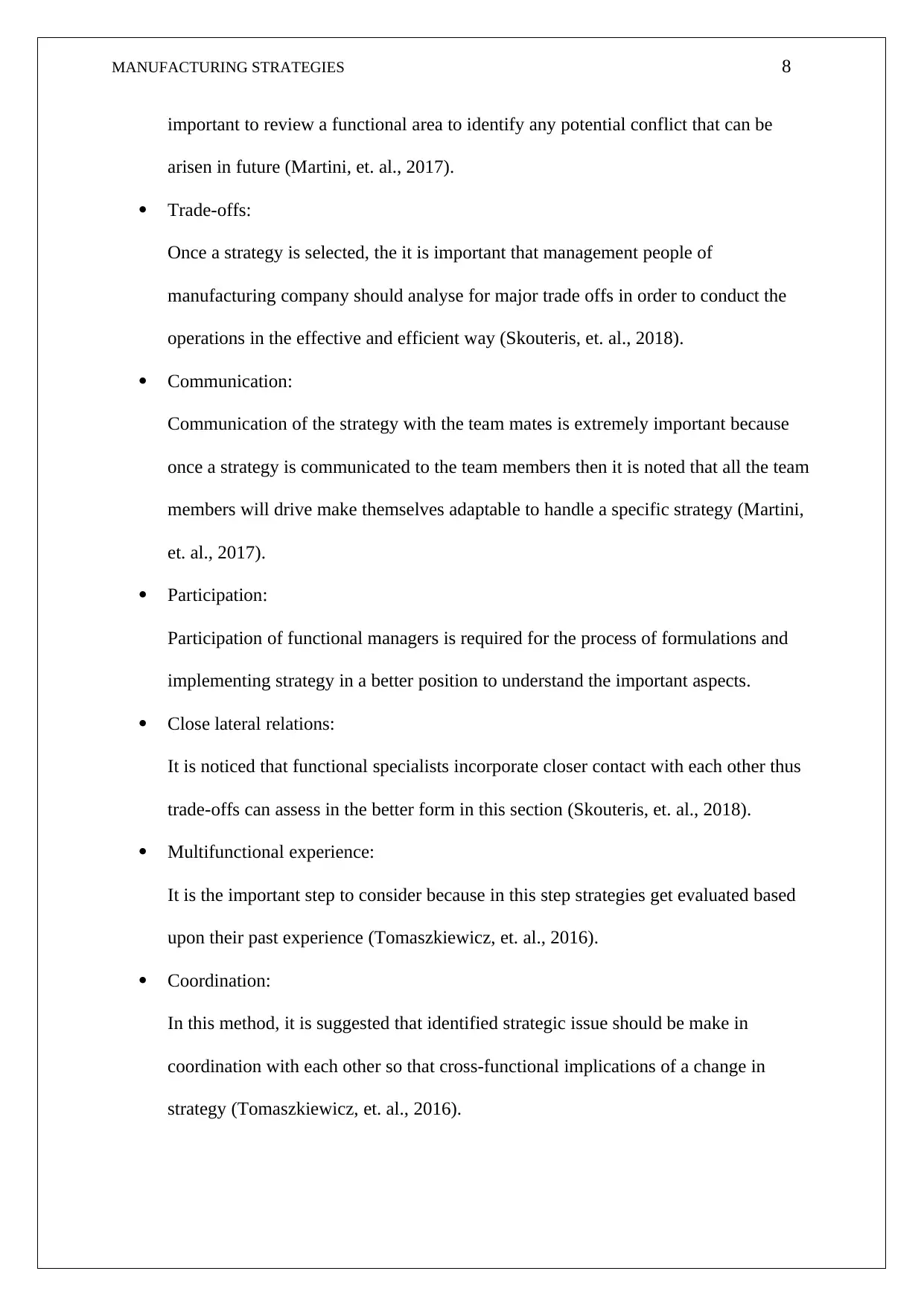
MANUFACTURING STRATEGIES 8
important to review a functional area to identify any potential conflict that can be
arisen in future (Martini, et. al., 2017).
Trade-offs:
Once a strategy is selected, the it is important that management people of
manufacturing company should analyse for major trade offs in order to conduct the
operations in the effective and efficient way (Skouteris, et. al., 2018).
Communication:
Communication of the strategy with the team mates is extremely important because
once a strategy is communicated to the team members then it is noted that all the team
members will drive make themselves adaptable to handle a specific strategy (Martini,
et. al., 2017).
Participation:
Participation of functional managers is required for the process of formulations and
implementing strategy in a better position to understand the important aspects.
Close lateral relations:
It is noticed that functional specialists incorporate closer contact with each other thus
trade-offs can assess in the better form in this section (Skouteris, et. al., 2018).
Multifunctional experience:
It is the important step to consider because in this step strategies get evaluated based
upon their past experience (Tomaszkiewicz, et. al., 2016).
Coordination:
In this method, it is suggested that identified strategic issue should be make in
coordination with each other so that cross-functional implications of a change in
strategy (Tomaszkiewicz, et. al., 2016).
important to review a functional area to identify any potential conflict that can be
arisen in future (Martini, et. al., 2017).
Trade-offs:
Once a strategy is selected, the it is important that management people of
manufacturing company should analyse for major trade offs in order to conduct the
operations in the effective and efficient way (Skouteris, et. al., 2018).
Communication:
Communication of the strategy with the team mates is extremely important because
once a strategy is communicated to the team members then it is noted that all the team
members will drive make themselves adaptable to handle a specific strategy (Martini,
et. al., 2017).
Participation:
Participation of functional managers is required for the process of formulations and
implementing strategy in a better position to understand the important aspects.
Close lateral relations:
It is noticed that functional specialists incorporate closer contact with each other thus
trade-offs can assess in the better form in this section (Skouteris, et. al., 2018).
Multifunctional experience:
It is the important step to consider because in this step strategies get evaluated based
upon their past experience (Tomaszkiewicz, et. al., 2016).
Coordination:
In this method, it is suggested that identified strategic issue should be make in
coordination with each other so that cross-functional implications of a change in
strategy (Tomaszkiewicz, et. al., 2016).
⊘ This is a preview!⊘
Do you want full access?
Subscribe today to unlock all pages.

Trusted by 1+ million students worldwide
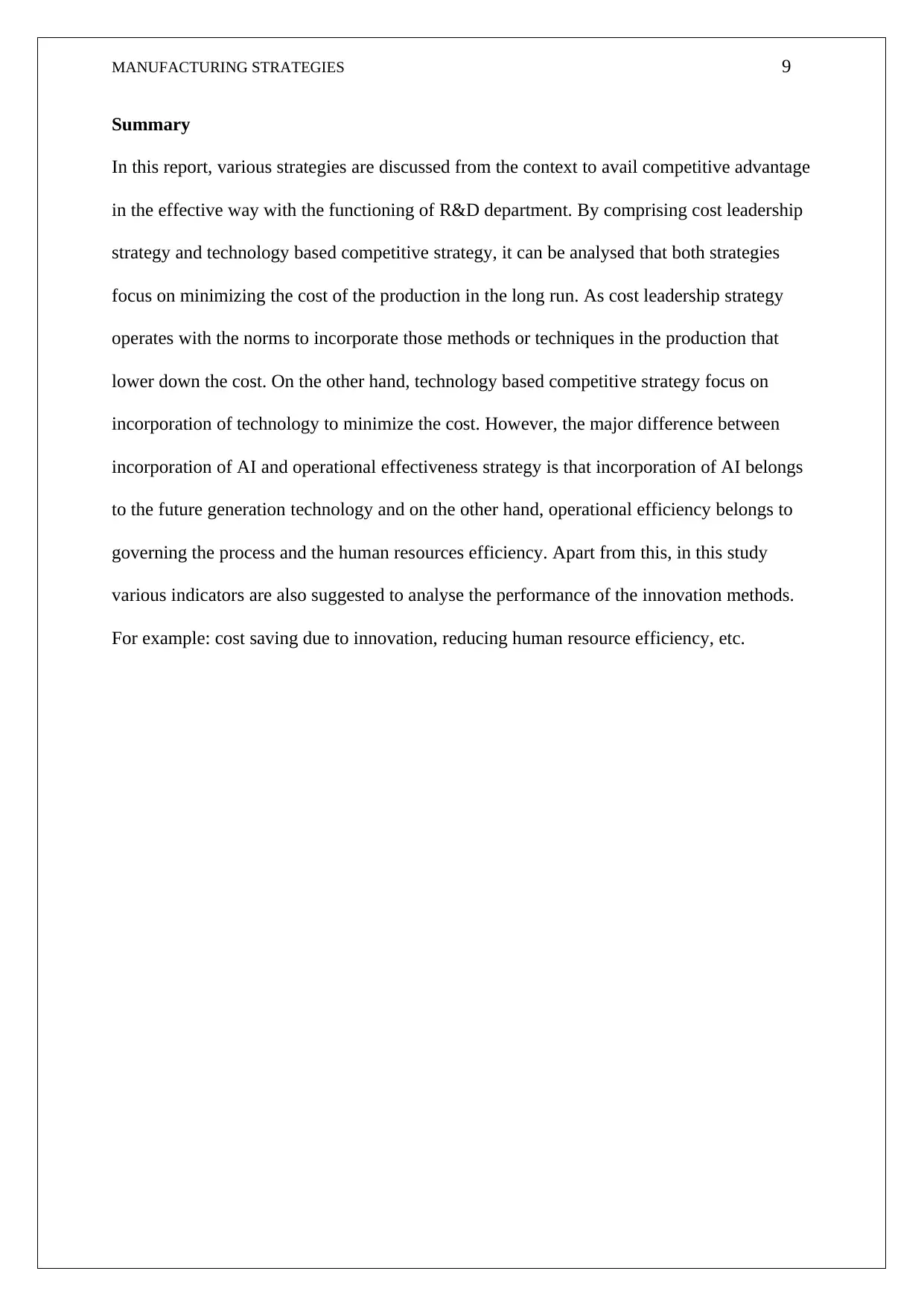
MANUFACTURING STRATEGIES 9
Summary
In this report, various strategies are discussed from the context to avail competitive advantage
in the effective way with the functioning of R&D department. By comprising cost leadership
strategy and technology based competitive strategy, it can be analysed that both strategies
focus on minimizing the cost of the production in the long run. As cost leadership strategy
operates with the norms to incorporate those methods or techniques in the production that
lower down the cost. On the other hand, technology based competitive strategy focus on
incorporation of technology to minimize the cost. However, the major difference between
incorporation of AI and operational effectiveness strategy is that incorporation of AI belongs
to the future generation technology and on the other hand, operational efficiency belongs to
governing the process and the human resources efficiency. Apart from this, in this study
various indicators are also suggested to analyse the performance of the innovation methods.
For example: cost saving due to innovation, reducing human resource efficiency, etc.
Summary
In this report, various strategies are discussed from the context to avail competitive advantage
in the effective way with the functioning of R&D department. By comprising cost leadership
strategy and technology based competitive strategy, it can be analysed that both strategies
focus on minimizing the cost of the production in the long run. As cost leadership strategy
operates with the norms to incorporate those methods or techniques in the production that
lower down the cost. On the other hand, technology based competitive strategy focus on
incorporation of technology to minimize the cost. However, the major difference between
incorporation of AI and operational effectiveness strategy is that incorporation of AI belongs
to the future generation technology and on the other hand, operational efficiency belongs to
governing the process and the human resources efficiency. Apart from this, in this study
various indicators are also suggested to analyse the performance of the innovation methods.
For example: cost saving due to innovation, reducing human resource efficiency, etc.
Paraphrase This Document
Need a fresh take? Get an instant paraphrase of this document with our AI Paraphraser
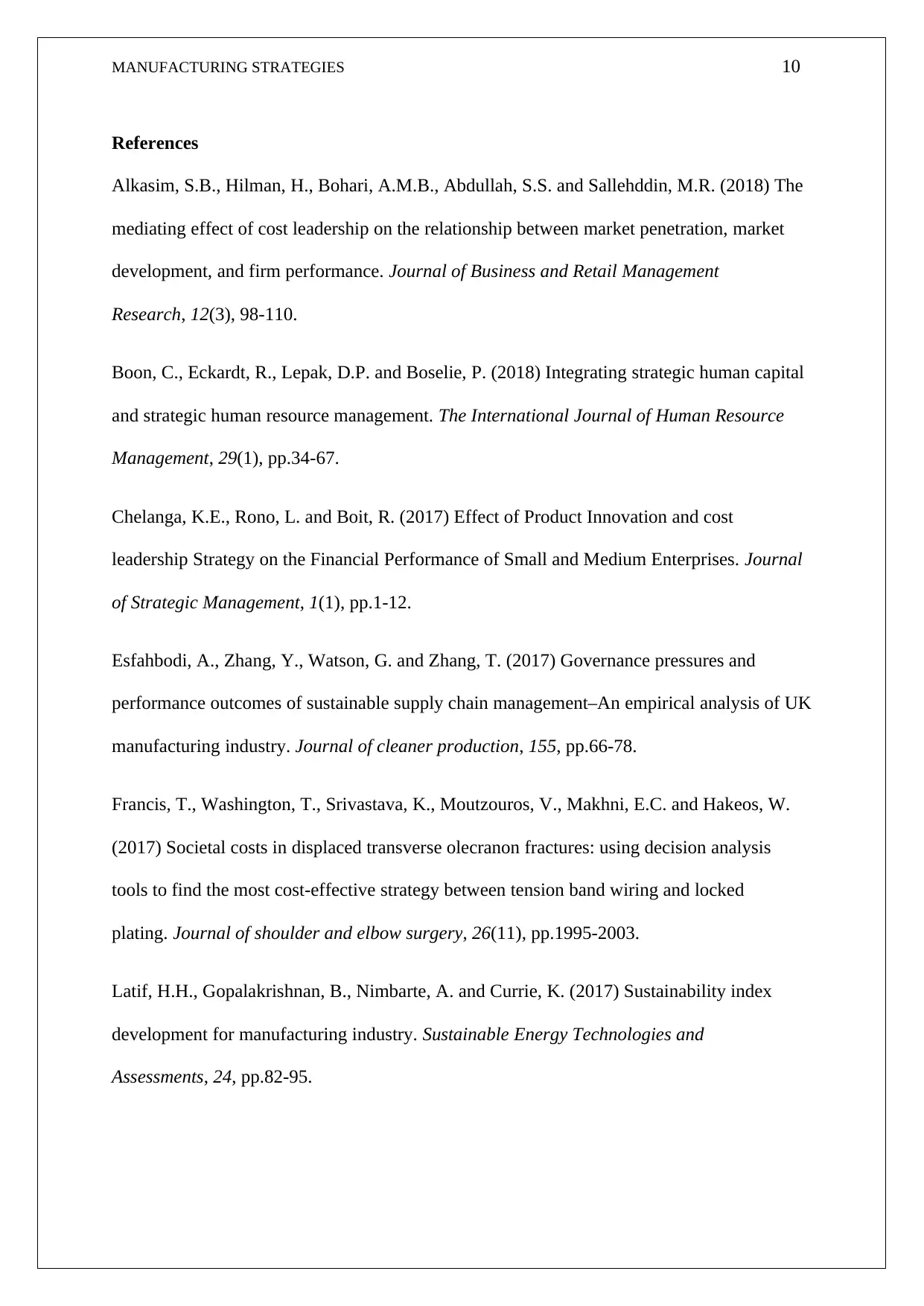
MANUFACTURING STRATEGIES 10
References
Alkasim, S.B., Hilman, H., Bohari, A.M.B., Abdullah, S.S. and Sallehddin, M.R. (2018) The
mediating effect of cost leadership on the relationship between market penetration, market
development, and firm performance. Journal of Business and Retail Management
Research, 12(3), 98-110.
Boon, C., Eckardt, R., Lepak, D.P. and Boselie, P. (2018) Integrating strategic human capital
and strategic human resource management. The International Journal of Human Resource
Management, 29(1), pp.34-67.
Chelanga, K.E., Rono, L. and Boit, R. (2017) Effect of Product Innovation and cost
leadership Strategy on the Financial Performance of Small and Medium Enterprises. Journal
of Strategic Management, 1(1), pp.1-12.
Esfahbodi, A., Zhang, Y., Watson, G. and Zhang, T. (2017) Governance pressures and
performance outcomes of sustainable supply chain management–An empirical analysis of UK
manufacturing industry. Journal of cleaner production, 155, pp.66-78.
Francis, T., Washington, T., Srivastava, K., Moutzouros, V., Makhni, E.C. and Hakeos, W.
(2017) Societal costs in displaced transverse olecranon fractures: using decision analysis
tools to find the most cost-effective strategy between tension band wiring and locked
plating. Journal of shoulder and elbow surgery, 26(11), pp.1995-2003.
Latif, H.H., Gopalakrishnan, B., Nimbarte, A. and Currie, K. (2017) Sustainability index
development for manufacturing industry. Sustainable Energy Technologies and
Assessments, 24, pp.82-95.
References
Alkasim, S.B., Hilman, H., Bohari, A.M.B., Abdullah, S.S. and Sallehddin, M.R. (2018) The
mediating effect of cost leadership on the relationship between market penetration, market
development, and firm performance. Journal of Business and Retail Management
Research, 12(3), 98-110.
Boon, C., Eckardt, R., Lepak, D.P. and Boselie, P. (2018) Integrating strategic human capital
and strategic human resource management. The International Journal of Human Resource
Management, 29(1), pp.34-67.
Chelanga, K.E., Rono, L. and Boit, R. (2017) Effect of Product Innovation and cost
leadership Strategy on the Financial Performance of Small and Medium Enterprises. Journal
of Strategic Management, 1(1), pp.1-12.
Esfahbodi, A., Zhang, Y., Watson, G. and Zhang, T. (2017) Governance pressures and
performance outcomes of sustainable supply chain management–An empirical analysis of UK
manufacturing industry. Journal of cleaner production, 155, pp.66-78.
Francis, T., Washington, T., Srivastava, K., Moutzouros, V., Makhni, E.C. and Hakeos, W.
(2017) Societal costs in displaced transverse olecranon fractures: using decision analysis
tools to find the most cost-effective strategy between tension band wiring and locked
plating. Journal of shoulder and elbow surgery, 26(11), pp.1995-2003.
Latif, H.H., Gopalakrishnan, B., Nimbarte, A. and Currie, K. (2017) Sustainability index
development for manufacturing industry. Sustainable Energy Technologies and
Assessments, 24, pp.82-95.
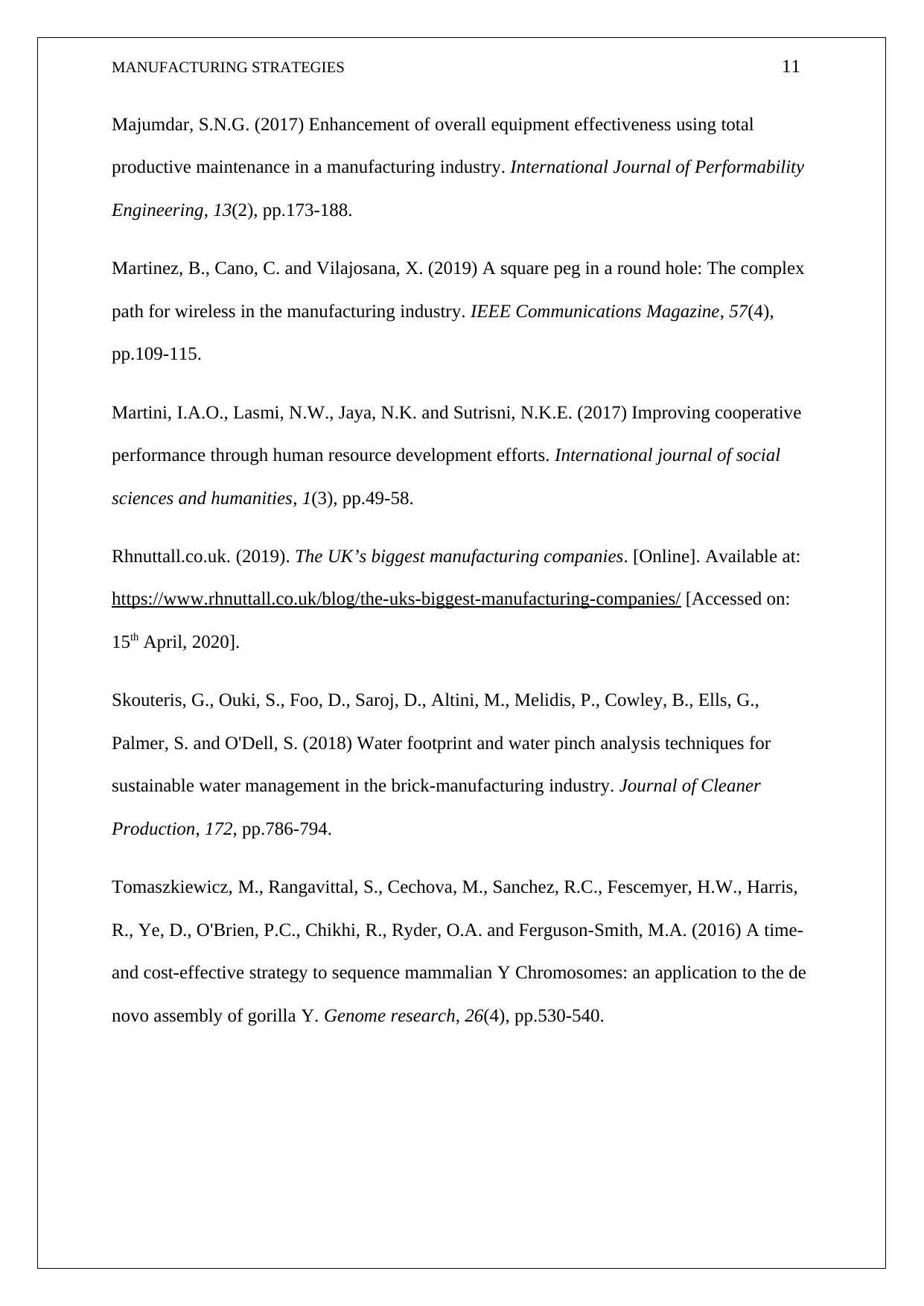
MANUFACTURING STRATEGIES 11
Majumdar, S.N.G. (2017) Enhancement of overall equipment effectiveness using total
productive maintenance in a manufacturing industry. International Journal of Performability
Engineering, 13(2), pp.173-188.
Martinez, B., Cano, C. and Vilajosana, X. (2019) A square peg in a round hole: The complex
path for wireless in the manufacturing industry. IEEE Communications Magazine, 57(4),
pp.109-115.
Martini, I.A.O., Lasmi, N.W., Jaya, N.K. and Sutrisni, N.K.E. (2017) Improving cooperative
performance through human resource development efforts. International journal of social
sciences and humanities, 1(3), pp.49-58.
Rhnuttall.co.uk. (2019). The UK’s biggest manufacturing companies. [Online]. Available at:
https://www.rhnuttall.co.uk/blog/the-uks-biggest-manufacturing-companies/ [Accessed on:
15th April, 2020].
Skouteris, G., Ouki, S., Foo, D., Saroj, D., Altini, M., Melidis, P., Cowley, B., Ells, G.,
Palmer, S. and O'Dell, S. (2018) Water footprint and water pinch analysis techniques for
sustainable water management in the brick-manufacturing industry. Journal of Cleaner
Production, 172, pp.786-794.
Tomaszkiewicz, M., Rangavittal, S., Cechova, M., Sanchez, R.C., Fescemyer, H.W., Harris,
R., Ye, D., O'Brien, P.C., Chikhi, R., Ryder, O.A. and Ferguson-Smith, M.A. (2016) A time-
and cost-effective strategy to sequence mammalian Y Chromosomes: an application to the de
novo assembly of gorilla Y. Genome research, 26(4), pp.530-540.
Majumdar, S.N.G. (2017) Enhancement of overall equipment effectiveness using total
productive maintenance in a manufacturing industry. International Journal of Performability
Engineering, 13(2), pp.173-188.
Martinez, B., Cano, C. and Vilajosana, X. (2019) A square peg in a round hole: The complex
path for wireless in the manufacturing industry. IEEE Communications Magazine, 57(4),
pp.109-115.
Martini, I.A.O., Lasmi, N.W., Jaya, N.K. and Sutrisni, N.K.E. (2017) Improving cooperative
performance through human resource development efforts. International journal of social
sciences and humanities, 1(3), pp.49-58.
Rhnuttall.co.uk. (2019). The UK’s biggest manufacturing companies. [Online]. Available at:
https://www.rhnuttall.co.uk/blog/the-uks-biggest-manufacturing-companies/ [Accessed on:
15th April, 2020].
Skouteris, G., Ouki, S., Foo, D., Saroj, D., Altini, M., Melidis, P., Cowley, B., Ells, G.,
Palmer, S. and O'Dell, S. (2018) Water footprint and water pinch analysis techniques for
sustainable water management in the brick-manufacturing industry. Journal of Cleaner
Production, 172, pp.786-794.
Tomaszkiewicz, M., Rangavittal, S., Cechova, M., Sanchez, R.C., Fescemyer, H.W., Harris,
R., Ye, D., O'Brien, P.C., Chikhi, R., Ryder, O.A. and Ferguson-Smith, M.A. (2016) A time-
and cost-effective strategy to sequence mammalian Y Chromosomes: an application to the de
novo assembly of gorilla Y. Genome research, 26(4), pp.530-540.
⊘ This is a preview!⊘
Do you want full access?
Subscribe today to unlock all pages.

Trusted by 1+ million students worldwide
1 out of 12
Related Documents
Your All-in-One AI-Powered Toolkit for Academic Success.
+13062052269
info@desklib.com
Available 24*7 on WhatsApp / Email
![[object Object]](/_next/static/media/star-bottom.7253800d.svg)
Unlock your academic potential
Copyright © 2020–2025 A2Z Services. All Rights Reserved. Developed and managed by ZUCOL.





